Intro
Discover how Venlafaxine works, its mechanism of action, and effects on serotonin, norepinephrine, and dopamine, explaining its role in treating depression, anxiety, and mood disorders.
The mechanism of action of venlafaxine, a commonly prescribed antidepressant, is complex and involves multiple neurotransmitter systems in the brain. Venlafaxine belongs to a class of medications known as serotonin-norepinephrine reuptake inhibitors (SNRIs), which work by increasing the levels of certain neurotransmitters in the brain. Understanding how venlafaxine works is essential for appreciating its therapeutic effects and potential side effects.
Venlafaxine's primary mechanism of action involves the inhibition of the reuptake of serotonin and norepinephrine, two neurotransmitters that play crucial roles in mood regulation. Serotonin is involved in various physiological and psychological processes, including mood, appetite, sleep, and cognition. Norepinephrine, on the other hand, is involved in attention, arousal, and stress response. By blocking the reuptake of these neurotransmitters, venlafaxine increases their availability in the synaptic cleft, the gap between two neurons, allowing them to interact with their respective receptors for a longer period.
The increased levels of serotonin and norepinephrine in the synaptic cleft lead to a cascade of downstream effects, including the activation of various signaling pathways and the modulation of gene expression. These effects contribute to the therapeutic benefits of venlafaxine, including improved mood, reduced anxiety, and enhanced cognitive function. Additionally, venlafaxine may also have neuroprotective effects, which could contribute to its long-term therapeutic benefits.
Venlafaxine Pharmacodynamics
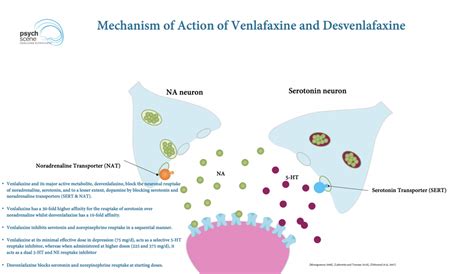
The pharmacodynamics of venlafaxine involve its interaction with various neurotransmitter systems, including serotonin, norepinephrine, and dopamine. Venlafaxine's affinity for the serotonin transporter is higher than its affinity for the norepinephrine transporter, which means that it preferentially increases serotonin levels at lower doses. At higher doses, venlafaxine also significantly increases norepinephrine levels, which may contribute to its therapeutic effects in treating depression and anxiety disorders.
Venlafaxine Receptor Binding
Venlafaxine's receptor binding profile is complex and involves multiple receptor subtypes. It has a high affinity for the serotonin transporter and a moderate affinity for the norepinephrine transporter. Venlafaxine also binds to various serotonin receptor subtypes, including 5-HT1A, 5-HT2A, and 5-HT3 receptors, although its clinical significance is not fully understood.Venlafaxine Pharmacokinetics
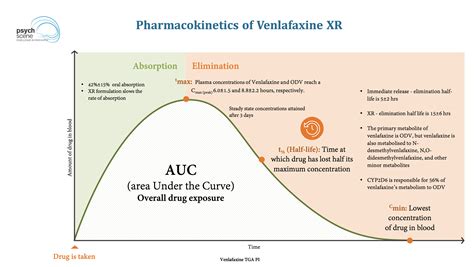
The pharmacokinetics of venlafaxine involve its absorption, distribution, metabolism, and excretion. Venlafaxine is well absorbed after oral administration, with a bioavailability of approximately 40-50%. It is extensively metabolized in the liver by the cytochrome P450 enzyme system, primarily by the CYP2D6 and CYP3A4 isoforms. The major metabolite of venlafaxine is O-desmethylvenlafaxine (ODV), which is also pharmacologically active and contributes to the therapeutic effects of venlafaxine.
Venlafaxine Metabolism
Venlafaxine's metabolism is complex and involves multiple metabolic pathways. The CYP2D6 enzyme is responsible for the formation of ODV, while the CYP3A4 enzyme is involved in the formation of other minor metabolites. The metabolism of venlafaxine can be influenced by various factors, including genetic polymorphisms, age, and concomitant medications.Venlafaxine Therapeutic Uses
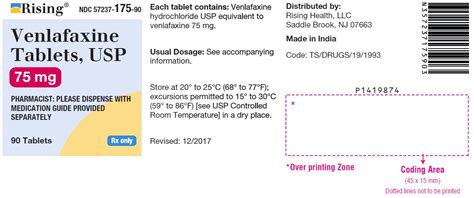
Venlafaxine is primarily used to treat major depressive disorder, generalized anxiety disorder, and social anxiety disorder. It is also used off-label to treat various other conditions, including post-traumatic stress disorder, attention deficit hyperactivity disorder, and chronic pain. The therapeutic benefits of venlafaxine are thought to be related to its ability to increase the levels of serotonin and norepinephrine in the brain, which helps to regulate mood, appetite, sleep, and other physiological processes.
Venlafaxine Dosing and Administration
Venlafaxine is available in various formulations, including immediate-release and extended-release tablets, as well as capsules. The dosing and administration of venlafaxine depend on the specific formulation and the patient's medical condition. The recommended starting dose for major depressive disorder is 75-100 mg per day, which can be titrated upward to a maximum dose of 225 mg per day.Venlafaxine Side Effects
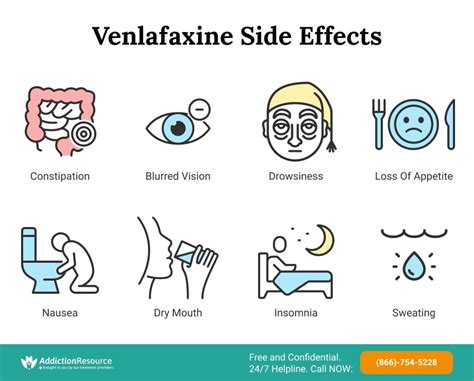
Venlafaxine is generally well tolerated, but it can cause various side effects, including nausea, headache, dry mouth, and insomnia. Other common side effects include dizziness, sweating, and changes in appetite or weight. Venlafaxine can also cause more serious side effects, such as serotonin syndrome, which is a potentially life-threatening condition that requires immediate medical attention.
Venlafaxine Contraindications
Venlafaxine is contraindicated in patients with a known hypersensitivity to the medication or its inactive ingredients. It is also contraindicated in patients taking monoamine oxidase inhibitors (MAOIs), as the combination can increase the risk of serotonin syndrome. Venlafaxine should be used with caution in patients with a history of seizures, as it can lower the seizure threshold.Venlafaxine Interactions
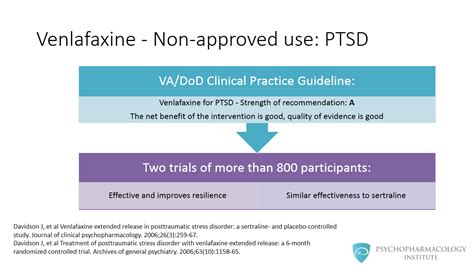
Venlafaxine can interact with various medications, including other antidepressants, antipsychotics, and anti-anxiety medications. It can also interact with certain supplements, such as St. John's Wort, which can increase the risk of serotonin syndrome. Patients taking venlafaxine should inform their healthcare provider about all medications and supplements they are taking to minimize the risk of interactions.
Venlafaxine Warnings and Precautions
Venlafaxine carries a boxed warning for increased risk of suicidal thoughts and behaviors in children, adolescents, and young adults. It should be used with caution in patients with a history of suicidal behavior or those who are at risk of suicide. Venlafaxine should also be used with caution in patients with a history of seizures, as it can lower the seizure threshold.Venlafaxine Overdose
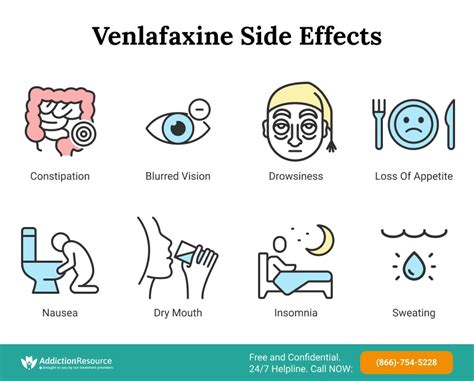
Venlafaxine overdose can be life-threatening and requires immediate medical attention. Symptoms of overdose include seizures, coma, and cardiac arrest. Patients who overdose on venlafaxine should be treated with supportive care, including cardiac monitoring and management of seizures and other complications.
Venlafaxine Withdrawal
Venlafaxine withdrawal can occur when the medication is stopped abruptly or the dose is reduced too quickly. Symptoms of withdrawal include dizziness, headache, and nausea. To minimize the risk of withdrawal, patients should taper off venlafaxine gradually under the guidance of their healthcare provider.Venlafaxine Pregnancy and Breastfeeding

Venlafaxine is classified as a Category C medication, which means that it may be harmful to the fetus if taken during pregnancy. Women who are pregnant or planning to become pregnant should discuss the risks and benefits of venlafaxine with their healthcare provider. Venlafaxine is also excreted in breast milk, and women who are breastfeeding should use caution when taking the medication.
Venlafaxine Geriatric Use
Venlafaxine can be used in geriatric patients, but it should be used with caution due to the increased risk of adverse effects. Older adults may be more sensitive to the effects of venlafaxine, and the dose may need to be adjusted accordingly.What is the primary mechanism of action of venlafaxine?
+The primary mechanism of action of venlafaxine involves the inhibition of the reuptake of serotonin and norepinephrine, two neurotransmitters that play crucial roles in mood regulation.
What are the therapeutic uses of venlafaxine?
+Venlafaxine is primarily used to treat major depressive disorder, generalized anxiety disorder, and social anxiety disorder. It is also used off-label to treat various other conditions, including post-traumatic stress disorder, attention deficit hyperactivity disorder, and chronic pain.
What are the common side effects of venlafaxine?
+Venlafaxine can cause various side effects, including nausea, headache, dry mouth, and insomnia. Other common side effects include dizziness, sweating, and changes in appetite or weight.
Can venlafaxine be used in pregnant or breastfeeding women?
+Venlafaxine is classified as a Category C medication, which means that it may be harmful to the fetus if taken during pregnancy. Women who are pregnant or planning to become pregnant should discuss the risks and benefits of venlafaxine with their healthcare provider. Venlafaxine is also excreted in breast milk, and women who are breastfeeding should use caution when taking the medication.
How should venlafaxine be discontinued?
+To minimize the risk of withdrawal, patients should taper off venlafaxine gradually under the guidance of their healthcare provider.
In summary, venlafaxine is a complex medication that works by increasing the levels of serotonin and norepinephrine in the brain. Its therapeutic benefits are thought to be related to its ability to regulate mood, appetite, sleep, and other physiological processes. While venlafaxine is generally well tolerated, it can cause various side effects, including nausea, headache, and insomnia. Patients who are taking venlafaxine should be aware of its potential interactions, contraindications, and warnings, and should use caution when discontinuing the medication. By understanding the mechanism of action, pharmacodynamics, and pharmacokinetics of venlafaxine, healthcare providers can optimize its use and minimize its risks. We invite readers to share their experiences with venlafaxine and to ask any questions they may have about this medication. Additionally, we encourage readers to share this article with others who may be interested in learning more about venlafaxine and its therapeutic uses.
